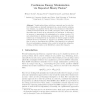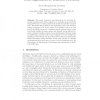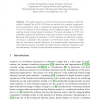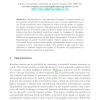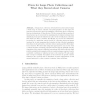92
Voted
ECCV
2008
Springer
16 years 2 months ago
2008
Springer
Abstract. Variational problems, which are commonly used to solve lowlevel vision tasks, are typically minimized via a local, iterative optimization strategy, e.g. gradient descent....
ECCV
2008
Springer
16 years 2 months ago
2008
Springer
Abstract. This paper presents a novel framework for detecting abnormal pedestrian and vehicle behaviour by modelling cross-correlation among different co-occurring objects both loc...
ECCV
2008
Springer
16 years 2 months ago
2008
Springer
Abstract. This paper proposes a novel curvilinear structure detector, called Optimally Oriented Flux (OOF). OOF finds an optimal axis on which image gradients are projected in orde...
110
Voted
ECCV
2008
Springer
16 years 2 months ago
2008
Springer
An approach to the analysis of images of regular texture is proposed in which lattice hypotheses are used to define statistical models. These models are then compared in terms of t...
111
Voted
ECCV
2008
Springer
16 years 2 months ago
2008
Springer
Object detection and pixel-wise scene labeling have both been active research areas in recent years and impressive results have been reported for both tasks separately. The integra...
108
click to vote
ECCV
2008
Springer
16 years 2 months ago
2008
Springer
Different materials reflect light in different ways, so reflectance is a useful surface descriptor. Existing systems for measuring reflectance are cumbersome, however, and although...
117
click to vote
ECCV
2008
Springer
16 years 2 months ago
2008
Springer
Computer vision has traditionally focused on extracting structure, such as depth, from images acquired using thin-lens or pinhole optics. The development of computational imaging i...
99
Voted
ECCV
2008
Springer
16 years 2 months ago
2008
Springer
In patch-based object recognition, using a compact visual codebook can boost computational efficiency and reduce memory cost. Nevertheless, compared with a large-sized codebook, it...
108
click to vote
ECCV
2008
Springer
16 years 2 months ago
2008
Springer
A large photo collection downloaded from the internet spans a wide range of scenes, cameras, and photographers. In this paper we introduce several novel priors for statistics of su...
105
click to vote
ECCV
2008
Springer
16 years 2 months ago
2008
Springer
We consider the problem of imaging a scene with a given depth of field at a given exposure level in the shortest amount of time possible. We show that by (1) collecting a sequence ...
